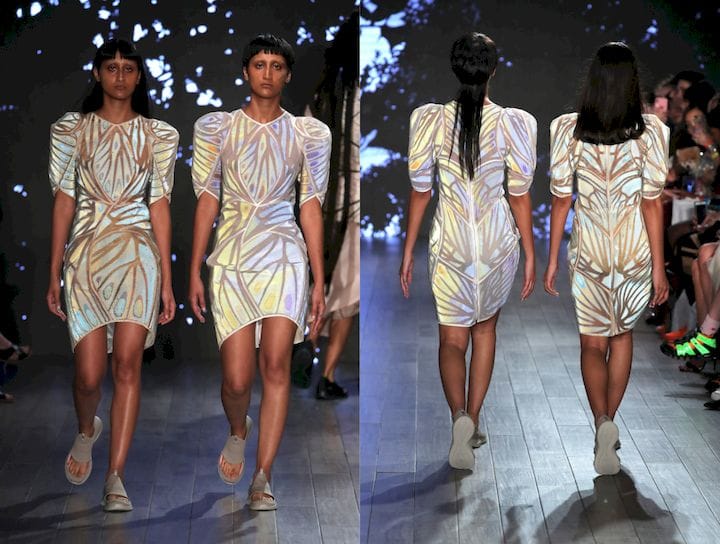![Stratasys coIIaborated with designers threeASFOUR and Travis Fitch for breakthrough Chro-Morpho CoIIection, featuring 3D printed fashion at New York Fashion Week [Source: Stratasys]](https://fabbaloo.com/wp-content/uploads/2020/05/image-asset_img_5eb090a84c0d0.jpg)
Stratasys has launched a new approach for 3D printing fashion by printing directly onto fabric.
The announcement was made during New York Fashion Week, where the company unveiled the new process, which leverages Stratasys’ existing full color 3D printing capabilities.
They explain their approach:
“Designers have used 3D printing in fashion for several years; however, printed elements have been created separately and affixed to garments. Stratasys sees the technique of printing directly on textiles, which provides unparalleled flexibility and integrity, as the key to creating modern, functional apparel and unlocking 3D printing’s commercial viability in the fashion industry.”
Stratasys Fabric 3D Printing Process
From what we understand, it seems that Stratasys is pinning 300 x 400 mm fabric segments to the build plate of their full color 3D printer, the J750. I’m not certain how pinning is done, but we are told that Stratasys is also working on developing a full “roll-to-roll” production process for this technique.
The 3D printer then merrily prints as it usually does, except that the material soaks into the fabric where deposited and is solidified. What you end up with is a fabric with 3D printed pieces built right into it. By spacing the printed portions, the fabric remains quite flexible.
![Detail of 3D printing on fabric. Note colored cells dotting the fabric [Source: Stratasys]](https://fabbaloo.com/wp-content/uploads/2020/05/image-asset_img_5eb090a8ba0c3.jpg)
This is quite a development, as one can imagine the thoughts running through fashion designers’ minds when told they could literally place any imaginable full color 3D structure onto fabric. What will they do? The possibilities are limitless!
Stratasys worked with several prominent designers to produce example fashions made using the new process. The fashions shown in this post are made using the fabric process.
Early Fabric 3D Printing
I should point out that the act of 3D printing directly on fabric has not been invented by Stratasys here. In fact, there have been many experiments using that approach for years, with a 3D printed fabric craze in 2018 and 3D printing on fabric in 2016. But there’s a big difference between those experiments and what Stratasys is doing.
The experiments were just that: experiments. Any 3D printer operator can easily 3D print on fabrics by simply pausing the print after the first layer and pinning down some fabric, then resuming printing. But that is a very manual process, and with most 3D printers, is limited to one or a couple of colors.
Stratasys Fashion Production
![Dress made from 3D prints on fabric [Source: Stratasys]](https://fabbaloo.com/wp-content/uploads/2020/05/3as4_2_img_5eb090a94f820.jpg)
Stratasys, as we mentioned above, seems to be developing a production process for doing this. A roll mechanism would be able to sweep in a new sheet of fabric as soon as the prior print completed. That is a bit of automation that you’d expect to see in a production system.
The other change is that the J750 technology is literally able to reproduce any color object, very unlike the experimental approaches. I’ve seen some 3D prints from this device that are effectively indistinguishable from “real” objects. I’m blown away by the possibilities here. Imagine a shirt that is covered in highly realistic eyeballs — that roll when moved! Or tiny wings that flap and change color when they flip up! Or a personalized jacket with a name — and image — of the owner.
You get the idea.
Stratasys Fashion Strategy
Stratasys has long been involved in the art and fashion world, having sponsored many fascinating art projects, such as Neri Oxman’s full color 3D prints in Paris in 2012. Now it seems they are moving from sponsored, one-time projects to a full production mode where they could sell equipment and services to the fashion industry at large.
This is very good news for Stratasys, as they seem to be opening up a new production market for 3D printing, one that has not truly been explored as yet. The market for full color 3D prints has been somewhat limited, and we’ve even seen one full color 3D printer manufacturer close down. Perhaps Stratasys’ step here will grow interest in full color 3D printing in other areas, too.
Via Stratasys

